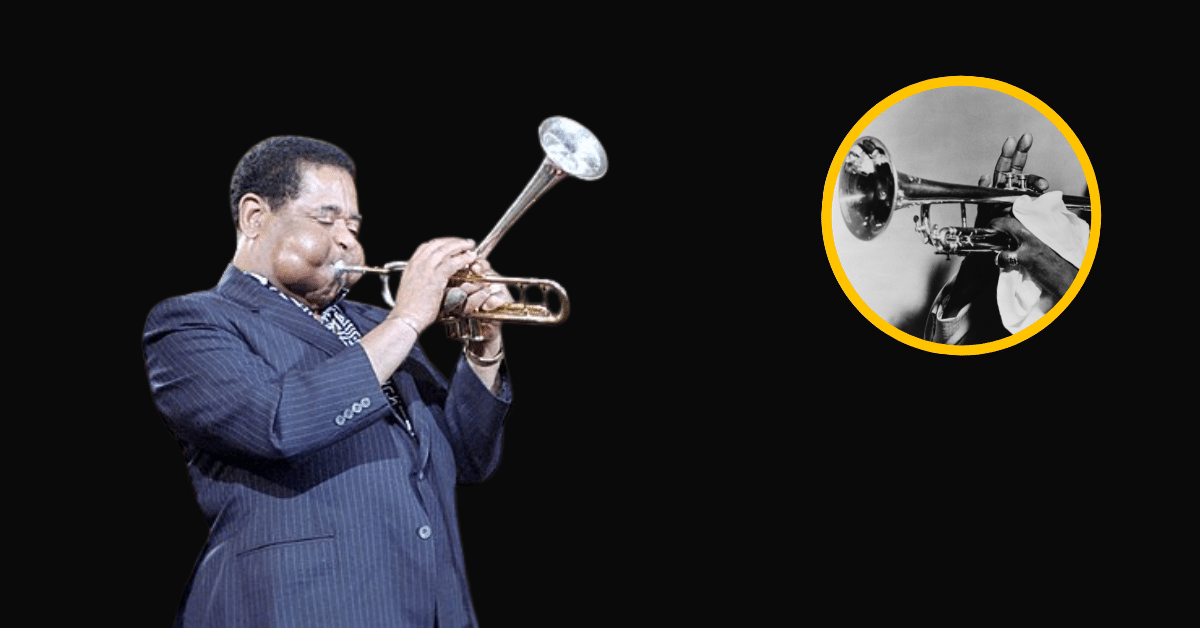A dropped trumpet. A bent bell. In 1953, a split-second accident gave Dizzy Gillespie the most recognisable horn in jazz — and a sound that became part of his signature.
Blistering high-wire trumpet lines and bebop mastery aside, Dizzy Gillespie already had plenty to set him apart. The puffed-out cheeks. The beret. The horn-rimmed glasses.

But the upturned bell of his trumpet?
It didn’t come from a clever design meeting, or a custom shop experiment. As Dizzy later wrote in his autobiography Dizzy: To Be or Not to Bop:
“The truth is that the shape of my horn was an accident. I could pretend that I went into the basement and thought it up, but it wasn’t that way. It was an accident.”
The Night Dizzy Gillespie’s Trumpet Got Bent
It was Monday, 6th January 1953.
Dizzy wasn’t even scheduled to play. He had the night off from Snookie’s on West 45th Street, but the club was hosting a birthday party for his wife Lorraine.
The guest list was a who’s who of the mid-century jazz and showbiz world: saxophonist Illinois Jacquet, vocalist Sarah Vaughan, the comedy duo Stump and Stumpy, plus musicians, dancers, and friends.
At some point during the night, the story goes, Dizzy left the club briefly to appear on Henry Morgan’s television show, which was being filmed around the corner. He left his trumpet — a straight-belled Martin — resting on a small stand.
When he returned, chaos had struck.
According to Dizzy, Stump and Stumpy had been fooling around on the bandstand. One shoved the other, who stumbled backwards into his horn.
“Instead of the horn just falling, the bell bent,” Dizzy wrote. “Nine hundred and ninety-nine times out of a thousand if someone fell on a horn, it would bend the valves… but this horn bent [at the bell].
When I got back, the bell was sticking up in the air.”
Illinois Jacquet had already slipped out, joking that he didn’t want to be there when Dizzy saw what had happened.
Playing the Damage
This could have been the moment for a meltdown. Instead, Dizzy decided not to ruin his wife’s party and gave the instrument a try.
What he heard—different due to the dents in the instrument, surprised him.
“I couldn’t get the right sound, but it was a strange sound… I played it, and I liked the sound.”
Curator John Edward Hasse of the Smithsonian Institution confirms the story in public records, noting that Gillespie “picked it up, played it, and discovered… it projected better.”
It wasn’t the tone he was used to — softer, less brash — but something about it worked. He played that way for the rest of the night.
From Accident to Idea
The next day, he had the horn straightened. But the sound from the bent bell stayed in his mind.
“I remembered the way the sound had come from it — quicker to the ear… A forty-five degree angle is much closer than ninety degrees.”
Dizzy contacted the Martin Company, asking them to make a trumpet with a 45-degree upturned bell. His wife Lorraine, who was an artist, sketched the design.
The reaction from Martin was predictable:
“‘You’re crazy!’ they said.
‘OK,’ I said. ‘I’m crazy, but I want a horn like this.’”
They built it — first with a detachable, screw-in angled bell, later as a single piece.
He can be seen using it as early as June 1956, as per this television appearance:
Why The Bent Trumpet Worked
Over time, Dizzy realised the bent bell offered real advantages.
On a tight club stage, it didn’t blast directly into the audience’s ears. When reading music, the bell never blocked the stand. And to him, the immediacy of the sound made a difference.
“It’s only a split second,” he wrote, “but the split second means a lot.”
The horn also changed the way audiences saw him.
Photographers loved the unusual silhouette — the gleaming curve pointing skyward, paired with his puffed cheeks and tilted beret.
It became as much a part of his image as the music itself.
A New Jazz Trademark
From 1953 onwards, Dizzy rarely appeared without his angled trumpet.
It didn’t alter his musical vocabulary — the bebop innovations had already been forged — but it gave him a visual identity no other trumpeter could match.
Over the years, other players experimented with similar designs, but none could claim the same story: a pure accident, turned into a lifelong trademark.
Dizzy’s Bent Trumpet: An Enduring Image
It’s tempting to see the bent bell as a gimmick — an easy visual hook.
For Gillespie, thuogh, the bent bell wasn’t just a quirk — it became part of his identity, as distinctive as his puffed cheeks, beret, and onstage charisma; a functional tool and an aesthetic statement rolled into one.
Today, photos of Dizzy with his upturned trumpet are instantly recognisable.
They’re shorthand for bebop, for showmanship, for the mix of precision and playfulness that defined his career.

In fact, such was the importance of the image that one of his bent trumpets was sold at auction house Christie’s in 1995 for a whopping $63,000.
But whilst we love a great story—particularly when it features one of the greatest jazz musicians of all time—it’s of course the music of Dizzy Gillespie which deserves the enduring focus.
For that, we’ve rounded up 10 iconic Dizzy Gillespie tunes for you to dig into.

